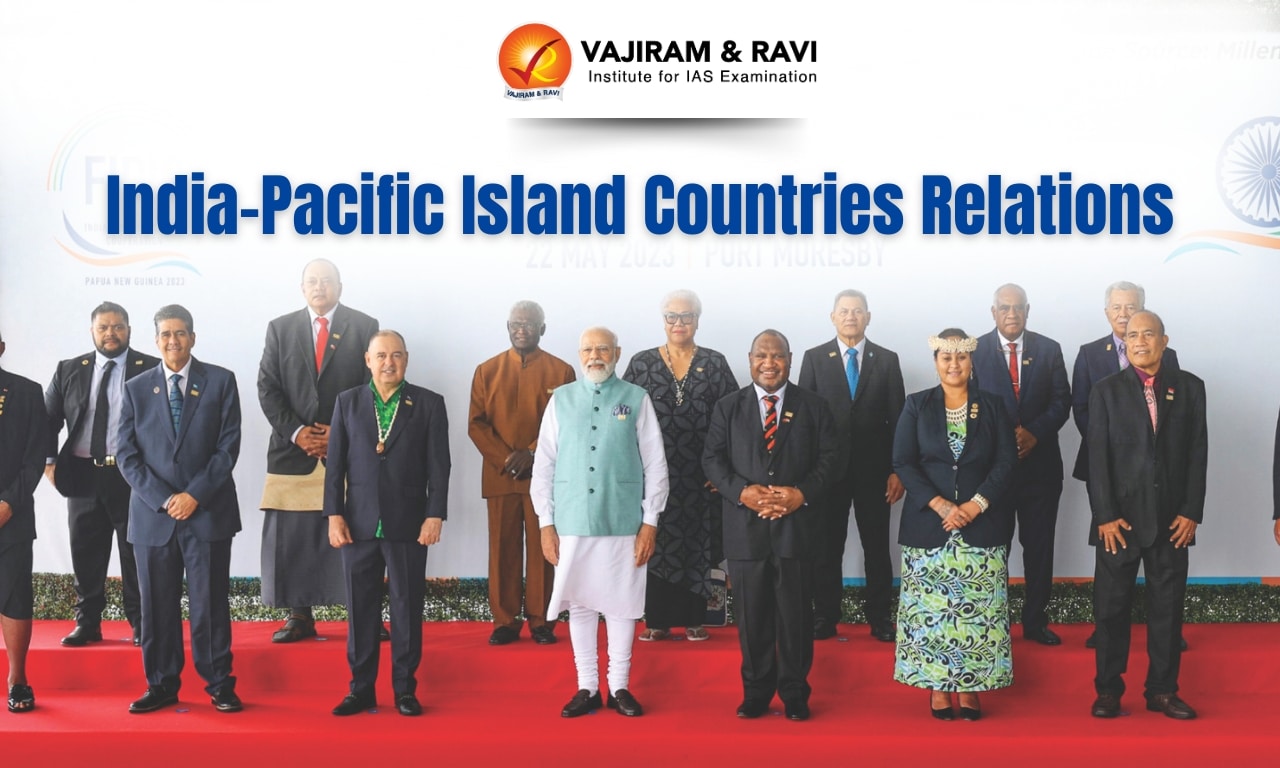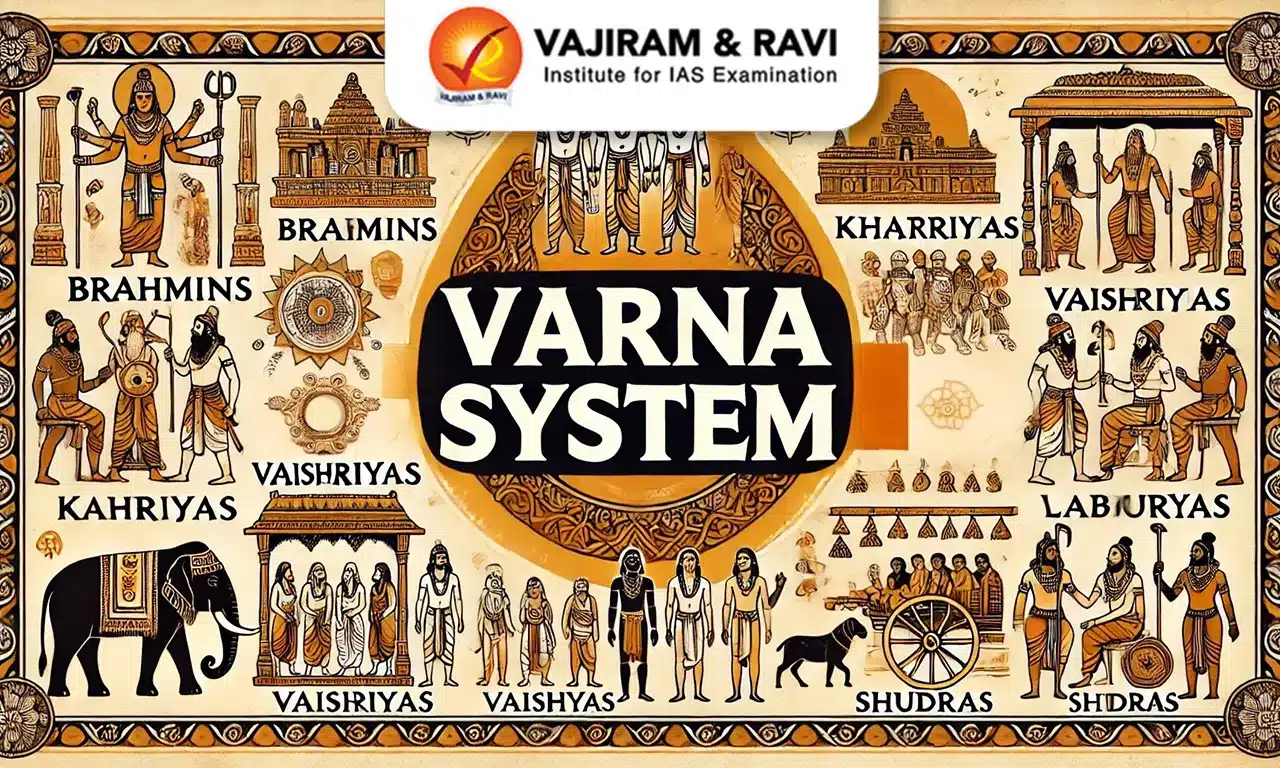What are Pacific Island countries?
The Pacific Islands consist of three major groups of islands: Melanesia, Micronesia, and Polynesia. Pacific Island countries (PIC) refer to the fourteen countries scattered in the South-West Pacific Ocean. These are as follows;
| Sovereign Countries (9) | Free association with New Zealand (2) | Free association with the USA (3) |
|
|
|
Associations/forums involving the PIC
Some of the association involving PIC are:
- Pacific Island Forum: The Pacific Islands Forum (PIF) is a regional intergovernmental organization that aims to promote cooperation and dialogue between its 18 member countries and territories in the Pacific. The forum was established in 1971 and is headquartered in Suva, Fiji.
- Partners in Blue Pacific: It is an informal mechanism involving five nations – the US, Australia, Japan, New Zealand, and UK, It aims at providing support to Pacific island countries and strengthening diplomatic and economic relationships in the region.
- It includes cooperation in areas like “climate crisis, connectivity and transportation, maritime security and protection, health, prosperity, and education”.
What is the significance of engagement with PIC?
Pacific Island countries are significant for a number of reasons:
- Strategic Location: The PIC is strategically located between Asia and the Americas. This location has made them important for trade and commerce, as well as for strategic military purposes.
- Economic factor: PIC are part of the larger Indo-Pacific region, which is vital to international trade, with 90% of such trade being transported via sea routes.
- Exclusive Economic Zones (EEZs): Despite being among the smallest and most sparsely populated states, PIC possesses some of the world’s most extensive and resource-rich EEZs.
- Geo-Political Importance: Many PICs are also members of regional organizations such as the Pacific Islands Forum, which have significant influence in regional and international affairs.
- Cultural Diversity: The Pacific Island countries are home to a rich cultural heritage, with diverse languages, traditions, and customs.
What are the developments in the relationship between India and PIC?
Some of the developments in the India PIC relationship are
- Forum for India-Pacific Islands Cooperation (FIPIC): It is a multinational grouping developed in 2014 for cooperation between India and 14 Pacific Islands nations.
- 1st Summit 2014: All heads of state or heads of government of the above countries met in Suva, Fiji, in November 2014, for the first time, where the annual summit was conceptualized.
- 2nd Summit 2015: The second summit of the Forum for India Pacific Cooperation (FIPIC-2) was organized in Jaipur on 21-22 August 2015.
- India-Fiji Bilateral relations: India and Fiji established diplomatic relations in 1970, soon after Fiji gained independence from Britain.
- India and Fiji have cooperated in areas like humanitarian assistance & disaster relief support, defense, agriculture and allied sector, training and development under the Indian Technical and Economic Cooperation(ITEC) program etc.
- Example:
- Establishment of Sustainable Coastal and Ocean Research Institute (SCORI) at Fiji was decided at second FIPIC summit in 2015,
- Fiji’s leading NGO, Sai Prema Foundation Fiji, has been awarded the prestigious “Pravasi Bharatiya Samman Award 2021” by the President of India.
- In 2022, INS Satpura visited Fiji as part of its operational deployment in the Pacific Ocean.
- Fiji hosted the 12th World Hindi Conference in 2023. It was based on the theme “Hindi-Traditional knowledge to Artificial Intelligence”.
What are the factors that could assist in strengthening India-PIC relations?
India can benefit in several areas from its relations with the PIC. Some of the potential advantages India could leverage in these relations include
- Shared history: Many Indian workers were taken to the region as indentured plantation laborers in the 19th century, and many of these workers settled in the PIC.
- This could serve as a foundation for strong relations between India and the PIC.
- Strong diaspora presence: The PIC, particularly Fiji and Papua New Guinea (PNG), have large Indian diaspora populations. These communities could serve as a bridge between India and the PIC, helping to strengthen cultural and economic ties between the countries.
- Climate change and sustainable development: PIC and India are both vulnerable to climate change impacts, like rising sea levels and extreme weather events. Collaborative efforts between the two regions can aid in climate change adaptation and mitigation.
- Blue Economy: Due to their resource-rich EEZs, the PIC can help the growth of India’s economy and support the idea of the blue economy.
- Strategic location: The PIC are located in the Indo-Pacific region, which is becoming increasingly important globally due to its role in international geopolitics.
- Growing economic and military power: India is a growing economic and military power, and the PIC are interested in collaborating with India in order to access its economic and military resources.
What could be the challenges to India’s newfound relationship with the PIC?
Some potential challenges to the relationship between India and PIC include
- Distance and logistics: The PIC are geographically isolated, making it difficult and costly for India to maintain strong relations with these countries.
- Limited economic ties: While the PIC have resource-rich EEZs that could be attractive to India, these countries have small populations and limited economic power, which could make it difficult for India to establish meaningful economic ties with them.
- Competition from other countries: China has been increasing its diplomatic efforts towards the Pacific Islands in recent times. This has caused regional powers like the US, Australia, and India to become more cautious about the shifting dynamics in the region.
- Limited diplomatic resources: Due to limited diplomatic resources, it could be difficult for India to devote sufficient resources to building and maintaining strong relations with the PIC.
- Cultural and linguistic differences: The PIC have diverse cultures and languages, which could make it challenging for India to establish strong cultural ties with these countries.
What should be the way forward to strengthen India’s relation with PIC?
Despite the above challenges, relations between India and PIC have been on an upward trajectory in recent times. It can be further strengthened in the following ways:
- Strengthening economic ties: India could explore opportunities to increase trade and investment with the PIC, particularly in sectors such as agriculture, fishing, and tourism.
- Enhancing cultural and people-to-people ties: India could work to build stronger cultural ties with the PIC through exchanges in areas such as education, sports, and the arts.
- Expanding diplomatic engagement: India could increase its diplomatic presence in the PIC and participate in regional organizations such as the Pacific Island Forum (PIF) to enhance its engagement with these countries.
- Leveraging shared values: India and the PIC may have shared values, such as a commitment to democracy and the rule of law, which could provide a basis for stronger relations between the countries.
- Identifying and addressing common challenges: India and the PIC may face common challenges such as climate change and sustainable development. India could work with the PIC to identify and address these challenges through collaborative initiatives.
Last updated on August, 2025
→ UPSC Mains Admit Card 2025 has been released on 14th August at www.upsc.gov.in.
→ UPSC Mains 2025 will be conducted on 22nd August 2025.
→ UPSC Notification 2025 was released on 22nd January 2025.
→ UPSC Calendar 2026 is released on 15th May, 2025.
→ UPSC Prelims Question Paper 2025 and Unofficial Prelims Answer Key 2025 are available now.
→ UPSC Prelims Result 2025 is out now for the CSE held on 25 May 2025.
→ The UPSC Vacancy 2025 were released 1129, out of which 979 were for UPSC CSE and remaining 150 are for UPSC IFoS.
→ UPSC Prelims 2026 will be conducted on 24th May, 2026 & UPSC Mains 2026 will be conducted on 21st August 2026.
→ The UPSC Selection Process is of 3 stages-Prelims, Mains and Interview.
→ UPSC Result 2024 is released with latest UPSC Marksheet 2024. Check Now!
→ UPSC Toppers List 2024 is released now. Shakti Dubey is UPSC AIR 1 2024 Topper.
→ Also check Best IAS Coaching in Delhi
India-Pacific Island Countries Relations FAQs
Q1. What three regions make up the Pacific Island Countries?+
Q2. What is an Exclusive Economic Zone?+
Q3. What is Blue Economy?+















